Reggio Emilia
Reggio nell'Emilia (US: /ˈrɛdʒ(i)oʊ ˌnɛlɛˈmiːljɑː/,[4][5] Italian: [ˈreddʒo nelleˈmiːlja; ˈrɛddʒo -] (![]()
Reggio Emilia Rèz (Emilian) | |
|---|---|
| Comune di Reggio nell'Emilia | |
 Piazza San Prospero in Reggio Emilia | |
 Flag Coat of arms | |
Location of Reggio Emilia 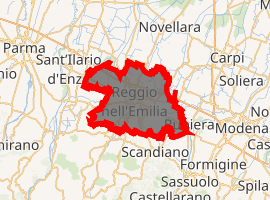
| |
 Reggio Emilia Location of Reggio Emilia in Italy 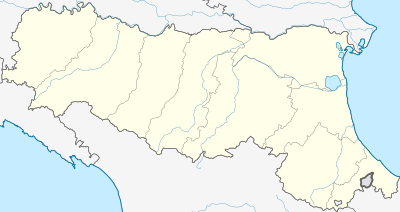 Reggio Emilia Reggio Emilia (Emilia-Romagna) | |
| Coordinates: 44°42′N 10°38′E[1] | |
| Country | Italy |
| Region | Emilia-Romagna |
| Province | Reggio Emilia (RE) |
| Frazioni | see list |
| Government | |
| • Mayor | Luca Vecchi (PD) |
| Area | |
| • Total | 231 km2 (89 sq mi) |
| Elevation | 58 m (190 ft) |
| Population (31 December 2017)[3] | |
| • Total | 171,944 |
| • Density | 740/km2 (1,900/sq mi) |
| Demonym(s) | Reggiano |
| Time zone | UTC+1 (CET) |
| • Summer (DST) | UTC+2 (CEST) |
| Postal code | 42121-42122-42123-42124 |
| Dialing code | 0522 |
| Patron saint | San Prospero |
| Saint day | November 24th |
| Website | Official website |
The inhabitants of Reggio nell'Emilia are called Reggiani, while the inhabitants of Reggio di Calabria, in the southwest of the country, are called Reggini.
The old town has a hexagonal form, which derives from the ancient walls, and the main buildings are from the 16th–17th centuries. The commune's territory lies entirely on a plain, crossed by the Crostolo stream.
History
Ancient and early Middle Ages
Reggio began as a historical site with the construction by Marcus Aemilius Lepidus of the Via Aemilia, leading from Piacenza to Rimini (187 BC). Reggio became a judicial administration centre, with a forum called at first Regium Lepidi, then simply Regium, whence the city's current name.
During the Roman age Regium is cited only by Festus and Cicero, as one of the military stations on the Via Aemilia. However, it was a flourishing city, a Municipium with its own statutes, magistrates and art colleges.
Apollinaris of Ravenna brought Christianity in the 1st century CE. The sources confirm the presence of a bishopric in Reggio after the Edict of Milan (313). In 440 the Reggio diocese was placed under the jurisdiction of Ravenna by Western Roman Emperor Valentinianus III. At the end of the 4th century, however, Reggio had decayed so much that Saint Ambrose included it among the dilapidated cities. Further damage occurred with the Barbarian invasions. After the deposition of Romulus Augustulus in 476 Reggio was part of Odoacer's realm. In 489 it came under Ostrogothic control; from 539 it was part of the Roman Empire (Italy), but was taken by Alboin's Lombards in 569. Reggio was chosen as Duchy of Reggio seat.
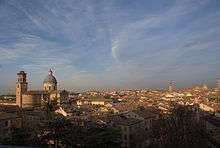
In 773 the Franks took Reggio. Charlemagne gave the bishop the authority to exercise royal authority over the city and established the diocese' limits (781). In 888 Reggio was handed over to the Kings of Italy. In 899 the Magyars heavily damaged it, killing Bishop Azzo II. As a result of this, new walls were built. On 31 October 900 Emperor Louis III gave authority for the erection of a castrum (castle) in the city's centre.
In 1002 Reggio's territory, together with that of Parma, Brescia, Modena, Mantua and Ferrara, were merged into the March of Tuscany, later held by Matilde of Canossa.
Free commune
Reggio became a free commune around the end of the 11th or the beginning of the 12th century. In 1167 it was a member of the Lombard League and took part in the Battle of Legnano. In 1183 the city signed the Treaty of Konstanz, from which the city's consul, Rolando della Carità, received the imperial investiture. The subsequent peace spurred a period of prosperity: Reggio adopted new statutes, had a mint, schools with celebrated masters, and developed its trades and arts. It also increasingly subjugated the castles of the neighbouring areas. At this time the Crostolo stream was deviated westwards, to gain space for the city. The former course of the stream was turned into an avenue called Corso della Ghiara (gravel), nowadays Corso Garibaldi.
The 12th and 13th century, however, were also a period of violent internal struggle between the Scopazzati (meaning "swept away from the city with brooms", nobles) and Mazzaperlini (meaning "lice killers", plebeians) parties, and later those of Ruggeri and Malaguzzi, involved in a bitter domestic rivalry. In 1152 Reggio also warred with Parma and in 1225 with Modena, as part of the general struggle between the Guelphs and Ghibellines. In 1260 25,000 penitents, led by a Perugine hermit, entered the city, and this event calmed the situation for a while, spurring a momentous flourishing of religious fervour. But disputes soon resurfaced, and as early as 1265 the Ghibellines killed the Guelph's leader, Caco da Reggio, and gained preeminence. Arguments with the Bishop continued and two new parties formed, the Inferiori and Superiori. Final victory went to the latter.
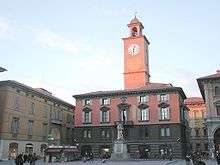
To thwart the abuses of powerful families such as the Sessi, Fogliani and Canossa, the Senate of Reggio gave the city's rule for a period of three years to Obizzo II d'Este. This choice marked the future path of Reggio under the seignory of the latter's family, as Obizzo continued to rule de facto after his mandate has ceased. His son Azzo was expelled by the Reggiani in 1306, creating a republic ruled by 800 common people. In 1310 the Emperor Henry VII imposed Marquis Spinetto Malaspina as vicar, but he was soon driven out. The republic ended in 1326 when Cardinal Bertrando del Poggetto annexed Reggio to the Papal States.
The city was subsequently under the suzerainty of John of Bohemia, Nicolò Fogliani and Mastino I della Scala, who in 1336 gave it to Luigi Gonzaga. Gonzaga built a citadel in the St. Nazario quarter, and destroyed 144 houses. In 1356 the Milanese Visconti, helped by 2,000 exiled Reggiani, captured the city, starting an unsettled period of powersharing with the Gonzaga. In the end the latter sold Reggio to the Visconti for 5,000 ducats. In 1405 Ottobono Terzi of Parma seized Reggio, but was killed by Michele Attendolo, who handed the city over to Nicolò III d'Este, who therefore became seignor of Reggio. The city, however, maintained a relevant autonomy, with laws and coinage of its own. Niccolò was succeeded by his illegitimate son Lionello, and, from 1450, by Borso d'Este.

Duchy of Reggio
In 1452 Borso was awarded the title of Duke of Modena and Reggio by Frederick III. Borso's successor, Ercole I, imposed heavy levies on the city and appointed the poet Matteo Maria Boiardo, born in the nearby town of Scandiano, as its governor. Later another famous Italian writer, Francesco Guicciardini, held the same position. In 1474, Ludovico Ariosto, author of Orlando Furioso, was born in the Malaguzzi palace, near the present day townhall. He was the first son of a knight from Ferrara, who was in charge of the Citadel, and a noblewoman from Reggio, Daria Maleguzzi Valeri. As a grown man he would be sent to Reggio as governor on behalf of the dukes of Ferrara, and would spend time in a villa outside the town ("Il Mauriziano") that still stands.
In 1513 Reggio was handed over to Pope Julius II. The city was returned to the Este after the death of Hadrian VI on 29 September 1523. In 1551 Ercole II d'Este destroyed the suburbs of the city in his program of reconstruction of the walls. At the end of the century work on the city's famous Basilica della Ghiara began, on the site where a miracle was believed to have occurred. The Este rule continued until 1796, with short interruptions in 1702 and 1733–1734.
Napoleonic age and restoration
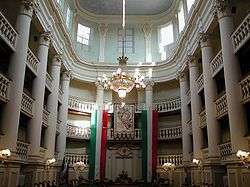

The arrival of the republican French troops was greeted with enthusiasm in the city. On 21 August 1796, the ducal garrison of 600 men was driven off, and the Senate claimed the rule of Reggio and its duchy. On 26 September, the Provisional Government's volunteers pushed back an Austrian column, in the Battle of Montechiarugolo. Though minor, this clash is considered the first one of the Italian Risorgimento. Napoleon himself awarded the Reggiani with 500 rifles and 4 guns. Later he occupied Emilia and formed a new province, the Cispadane Republic, whose existence was proclaimed in Reggio on 7 January 1797. The Italian national flag, named Il Tricolore (three-colours flag), was sewn on that occasion by Reggio women. In this period of patriotic fervour, Jozef Wybicki, a lieutenant in the Polish troops of General Jan Henryk Dąbrowski, an ally of Napoleon, composed in Reggio the Mazurek Dąbrowskiego, which in 1927 became the Polish national anthem.
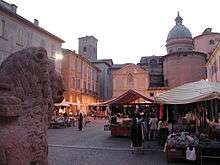
The 1815 Treaty of Vienna returned Reggio to Francis IV of Austria-Este, but in 1831 Modena rose up against him, and Reggio followed its example organizing a corps under the command of General Carlo Zucchi. However, on 9 March, the Duke conquered the city with his escort of Austrian soldiers.
In 1848 Duke Francis V left his state fearing a revolution and Reggio proclaimed its union with Piedmont. The latter's defeat at the Novara brought the city back under the Este control. In 1859 Reggio, under dictator Luigi Carlo Farini, became part of the united Italy and, with the plebiscite of 10 March 1860, definitively entered the new unified Kingdom.
Contemporary history
Reggio then went through a period of economic and population growth from 1873 to the destruction of the ancient walls. In 1911 it had 70,000 inhabitants. A strong socialist tradition grew. On 7 July, the city hosted the 13th National Congress of the Italian Socialist Party. On 26 July 1943, the fascist régime's fall was cheered with enthusiasm by the Reggiani. Numerous partisan bands were formed in the city and surrounding countryside.
Jewish history
Jews began arriving to Reggio in the early 15th century. Many Jews were Sephardim from Spain, Portugal and other parts of Italy. Nearly all were fleeing religious persecution. The Jewish community was prosperous and enjoyed considerable growth for the next several hundred years. A synagogue was built in 1672 and was used by the Jewish community of Reggio Emilio until 1858.[6]
After the Napoleonic era the Jews of Reggio gained emancipation and began to migrate to other parts of Europe looking for greater economic and social freedom. Thus, the Jewish community in Reggio began to decline. The German occupation during World War II and the Holocaust hastened the decline. Today, only a handful of Jewish families remain in Reggio. However, a functioning synagogue and burial ground still exist. In 2016 the City Council posed some small street plates in front of the houses of the deported Jews to preserve their remembrance.[7]
Many notable rabbinic scholars have resided in Reggio. These include Isaac Foa, Immanuel Sonino, Obadiah ben Israel Sforno, Nathan ben Reuben David Spira, Menahem Azariah Fano, Baruch Abraham ben Elhanan David Foa, Hezekiah ben Isaac Foa, Isaac ben Vardama Foa, Israel Nissim Foa, Israel Solomon Longhi, Isaiah Mordecai ben Israel Hezekiah Bassani, Israel Benjamin ben Isaiah Bassani, Elhanan David Carmi, Benjamin ben Eliezer ha-Kohen, Joshua ben Raphael Fermi, Moses Benjamin Foa, Abram Michael Fontanella, Judah Ḥayyim Fontanella, Israel Berechiah Fontanella, Raphael Jehiel Sanguinetti, Isaac Samson d'Angeli, R. J. Bolognese, Hananiah Elhanan Ḥai ha-Kohen, Jacob Levi, Moses Benjamin Levi, Israel Berechiah Sanguinetti, David Jacob Maroni, Giuseppe Lattes, Alessandro da Fano, and Lazzaro Laide Tedesco.[8] [9]
Climate
The climate in Reggio Emilia is temperate continental, with hot rather moist summers (the temperatures can sometimes rise above 35 °C) (95°F) and fairly rigid winters with frequent frosts (the temperatures can go below -10 °C)(14°F).[10] Precipitations are evenly distributed all year long, but October, November and April are the most rainy months, while July and January are the most arid.[11][12] In the city you can rarely see snow, even though almost every year there is a period when it's snowing. Due to the rather high temperatures, it does not settle, or if it does, the layer of snow is not very consistent.
During Autumn and Winter it is very common, especially in the areas outside the city, to encounter very thick fog, even though nowadays it is less frequent than in the past. Other meteorological phenomena that one can expect in the area is the hard rain, freezing rain during winter, and hail during summer but rarely during spring.
The area is not particularly windy and there are often days of total calm, especially during the anticyclonic phases in winter, while spring is more ventilated.[13] The most intense winds are the ones blowing from North-East (Bora) or from South-West (Libeccio). The latter, during its descent from the Northern Apennines, it sometimes tends to become a downslope wind and thus being very dry and hot. In rare and particular conditions, the downwind of the Alps, the Foehn, can reach Reggio Emilia from the North-West. In Reggio Emilia, the average annual high temperature is 18 °C (64 °F), the annual low temperature is 9 °C (48 °F), and the annual precipitation is 700 millimetres (27.56 inches)
| Climate data for Reggio Emilia (1961–1990) | |||||||||||||
|---|---|---|---|---|---|---|---|---|---|---|---|---|---|
| Month | Jan | Feb | Mar | Apr | May | Jun | Jul | Aug | Sep | Oct | Nov | Dec | Year |
| Average high °C (°F) | 4.2 (39.6) |
7.2 (45.0) |
12.8 (55.0) |
17.2 (63.0) |
22.3 (72.1) |
26.8 (80.2) |
29.6 (85.3) |
28.8 (83.8) |
24.2 (75.6) |
17.5 (63.5) |
10.5 (50.9) |
5.5 (41.9) |
17.2 (63.0) |
| Daily mean °C (°F) | 1.3 (34.3) |
3.7 (38.7) |
8.5 (47.3) |
12.6 (54.7) |
17.3 (63.1) |
21.5 (70.7) |
24.0 (75.2) |
23.4 (74.1) |
19.5 (67.1) |
13.7 (56.7) |
7.7 (45.9) |
2.9 (37.2) |
13.0 (55.4) |
| Average low °C (°F) | −1.6 (29.1) |
0.1 (32.2) |
4.2 (39.6) |
8.1 (46.6) |
12.3 (54.1) |
16.2 (61.2) |
18.5 (65.3) |
18.1 (64.6) |
14.7 (58.5) |
10.0 (50.0) |
4.9 (40.8) |
0.4 (32.7) |
8.8 (47.8) |
| Average precipitation mm (inches) | 47 (1.9) |
45 (1.8) |
58 (2.3) |
73 (2.9) |
71 (2.8) |
57 (2.2) |
35 (1.4) |
39 (1.5) |
57 (2.2) |
84 (3.3) |
77 (3.0) |
57 (2.2) |
700 (27.6) |
| Source: Archivio climatico Enea-Casaccia[14] | |||||||||||||
Government
Childhood education
The Reggio Emilia approach to preschool education was started by the schools of Reggio Emilia after World War II and is well known around the world. It is based and inspired on theories of Malaguzzi, Bruner, Vygotsky, Dewey, Piaget and Gardner. Reggio Emilia holds the Loris Malaguzzi International Centre, a modern structure where the Reggio Emilia approach is implemented, exported and spread around the world.[15]
Economy
The economy of the province of Reggio Emilia was for a long time based on agriculture. One typical product, known worldwide and imitated, is Parmigiano-Reggiano cheese. Another is Lambrusco wine.
Reggio Emilia produce also the[16] "Balsamic Vinegar" a condiment for salad but also cheese, strawberries and many other dishes.
In the twentieth century Reggio Emilia and its territory saw also a rapid development of small industries, particularly in the sector of mechanics for agriculture. A few of those industries became large companies, with an international market: Lombardini Motori, Landini.
Reggio Emilia is also the place of some fashion groups of various range and importance, since the last half of the twentieth century; the Max Mara clothing line is headquartered in the city. Another well-established branch is ceramic tiles industry (mainly in the district of Scandiano and Casalgrande).
New developments in mechanics and information technology are at the origin of some new companies operating in mechatronics.
Since more than 100 years, a strong tradition supports building and banking cooperatives, as well as consumers'cooperatives.
The industrial growth has attracted immigration from North and Central Africa, East Europe, and Far East (China, Pakistan, India). The immigration rate in the province is about 25%.
Researches on the quality of life[17] indicate that in recent years Reggio Emilia is in very good position among Italian provinces.
Transport
Reggio Emilia railway station, opened in 1859, forms part of the Milan–Bologna railway. It is also a terminus of three secondary railways, linking Reggio Emilia with Ciano d'Enza, Guastalla and Sassuolo, respectively. The station is situated at Piazza Guglielmo Marconi, at the eastern edge of the city centre.
The other major railway station, Reggio Emilia AV Mediopadana, is on the Milan–Bologna high-speed railway (there is also a connection with Reggio Emilia-Guastalla railway). It is located at the Mancasale locality, approximately 4 kilometres (2.5 miles) north from the city centre.
Sports
Reggio Emilia is home to various professional sports clubs and arenas:
- Pallacanestro Reggiana, which competes in basketball Serie A and has won 1 Italian Supercup and 1 Eurochallenge.
- A.C. Reggiana 1919, currently competing in Serie C after a lot of seasons in Serie A and Serie B.
- Rugby Reggio, playing in Eccellenza (Italian rugby top division).
- Volley Tricolore, playing in Serie A2.
- Kaos Reggio Emilia, playing in futsal Serie A and formed in 2017 after the merging of F.lli Bari Reggio Emilia and Kaos Futsal Ferrara.
The main sports venues in the city are:
- Stadio Città del Tricolore (23.717 capacity), located near the A1 highway and home to Reggiana and U.S. Sassuolo home games.
- PalaBigi (4.500 capacity), located in city centre.
- Stadio Mirabello (4.500 capacity), located in the city centre.
- Palasport Fanticini, located in the Tribunal hub.
- Stadio Canalina, located in the Canalina borough.
Main sights
Religious buildings
- Basilica della Ghiara: Main church of the city; begun in 1597, and completed in Baroque style.
- Basilica di San Prospero: Built in the 10th century and dedicated to Prosper of Reggio, a bishop of the city, it was rebuilt by Luca Corti and Matteo Fiorentini between 1514 and 1523. The façade, with eleven statues of saints and patrones, was redesigned by Giovan Battista Cattani in the mid-18th century. It includes a pleasant belfry/tower, begun in 1535 and never quite finished, with an octagonal plant. The interior of the church has a Latin cross plant, with three naves. The apse houses the splendid fresco Last Judgement, by the Bolognese artist Camillo Procaccini. Also noteworthy are the wooden choir from 1546 and the Assumption altarpiece by Tommaso Laureti and Ludovico Carracci (1602).
- Cathedral: Built in 9th through 12th centuries. It was rebuilt in the second half of the 16th century. It has three naves with works by Guercino, Palma the Younger, Prospero Spani and Alessandro Tiarini.
- Baptistery of Saint John the Baptist.
- Church of Sant'Agostino: Once dedicated to Saint Apollinaris, its dedication was changed to St Augustine in 1268 when it was rebuilt, along with the annexed convent, by the Augustinian friars. It was restored in 1452, when the tower was also erected. The current interior dates from 1645–1666, while the façade (1746) was designed by Alfonso Torreggiani and built by Giovan Battista Cattani. Its restored theatre hosted Model European Parliament sessions in 2015.
- The small Baroque Christ's Oratory.
- Church of San Girolamo e Vitale (mentioned in document in 857) and rebuilt in 1646 by Gaspare Vigarani. It really consists of three separate churches in the same building, two above ground and one underground; the crypt church houses a replica of the Holy Sepulcher in Jerusalem.
- Church of San Francesco.
- Church of San Giorgio: Baroque church with cupola (1746) designed by Alfonso Torreggiani.
- Church of San Giovannino: (dedicated to Saint John the Evangelist) built in 1545. It houses Baroque frescoes made in 1613 by Sisto Badalocchio, Lorenzo Franchi, Tommaso Sandrini, Paolo Guidotti and paintings by Tiarini.
- Church of St. Peter and St. Prospero, designed by Giulio della Torre and built in 1586 (the cupola in 1625). A façade was added in 1782, while the cloisters were constructed in the 16th century (the small cloister by Bartolomeo Spani in 1520, the works in the main cloister ended in 1580). The interior is in a Latin cross shape with a single nave. It houses notable Baroque paintings by Alessandro Tiarini, Pietro Desani, Luca da Reggio, Camillo Gavasetti and Paolo Emilio Besenzi.Greater cloister of Saint Peter
- San Filippo Neri: The Baroque church of St. Philip Neri.
- Church of San Stefano mentioned when its site was outside the city walls, as a Templars' church.
- Sinagoga di Reggio Emilia rebuilt in 1845 by Pietro Marchelli.
- Chiesa Battista la Verità Main Baptist church of Reggio Emilia.
Secular buildings
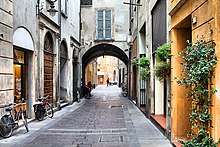
- Bishop's Palace.
- Palazzo Ancini.
- Palazzo Busetti.
- Palazzo del Capitano del Popolo (1280, restored in 1432, and again in the 1920s, when its northern and western façades were embellished with Ghibelline merlons and crests of ancient Reggio's Captains and Communities. In the interior is the Sala dei Difensori, "Defenders' Room"), a wide hall once used for the council of the Reggiani people.
- Palazzo del Carbone.
- Palazzo Cassoli.
- Palazzo Cassoli - Tirelli.
- Palazzo Comunale (begun in 1414), with the Tricolore Hall and the Museum of the Italian Flag. The Torre del Bordello ("Brothel Tower"), built in 1489, houses a museum of the Reggiani's deeds of 1796–1831.
- Palazzo Corbelli.

- Palazzo Ducale (18th century) – see italian article.
- Palazzo Magnani.
- Palazzo Masdoni.
- Palazzo Rangone.
- Palazzo Sacrati-Terrachini.
- Palazzo Scaruffi.
- Palazzo Spaletti-Trivelli
- Palazzo Tirelli.
- Palazzo Torello Malaspina.
- The Neo-Classical Teatro Municipale.
- Teatro Ariosto - see Italian article.
Bridges
- Autostrada A1 bridges, three bridges designed by Santiago Calatrava and opened in 2005–2006.[18] The three bridges connect the Austostrada del Sole A1 (the main Italian north to south motorway) to the city of Reggio Emilia.[18] A central arch bridge spans the Milan-Bologna high-speed railway line and the motorway, while twin cable-stayed bridges are at either end.[18][19] The twin bridges pass over service roundabouts and access roads to allow connections with the adjacent Reggio Emilia AV Mediopadana high-speed railway station.[18]
- In 2009, the European Convention for Constructional Steelwork gave the three bridges a European Steel Design Award, stating that the twin bridges' original visual effects at different angles give the two bridges "the aspect of huge musical instruments."[19]
Painters and sculptors
- Giacomo Benevelli
- Francesco Burani
- Antonio da Correggio ("Il Correggio")
- Raffaellino da Reggio
- Paolo da San Leocadio
- Luca Ferrari ("Luca da Reggio")
- Antonio Fontanesi
- Anselmo Govi
- Cristoforo Munari
- Lelio Orsi
- Prospero Spani ("Il Clemente")
- Antonio Ligabue
Other notable people
- Elvis Abbruscato (footballer)
- Daniele Adani (former footballer and TV pundit)
- Carlo Ancelotti (football manager and former footballer)
- Luca Ariatti (former footballer)
- Ludovico Ariosto (poet)
- Stefano Baldini (marathon champion)
- Benny Benassi (musician)
- Matteo Maria Boiardo (poet)
- Kobe Bryant (American basketball player; lived in Reggio Emilia in his youth)
- Riccardo Cervi (basketball player)
- Philip Corner (composer, Fluxus artist)
- Graziano Delrio (politician)
- Giuseppe Dossetti (politician)
- Zucchero Fornaciari (singer)
- Sonia Ganassi (opera singer)
- Gino Giaroli (former footballer)
- Luigi Ghirri (photographer)
- Giovanni Guicciardi (opera singer)[20]
- Nilde Iotti (politician)
- Luciano Ligabue (singer)
- Hachim Mastour (footballer)
- Federico Mussini (basketball player)
- Simone Nobili (model)
- Antonio Pacchioni (scientist)
- Romano Prodi (economist, politician)
- Serge Reggiani (actor, singer)
- Meuccio Ruini (politician)
- Angelo Secchi (scientist)
- Lazzaro Spallanzani (scientist)
- Ferruccio Tagliavini (opera singer)
- Pier Vittorio Tondelli (writer)
- Romolo Valli (actor)
- Giovanni Battista Venturi (scientist)
- Ermete Zacconi (actor)
- Cesare Zavattini (writer, painter)
- CCCP Fedeli alla linea (band)
- Offlaga Disco Pax (band)
- Raw Power (band) (band)
Frazioni (hamlets)
- Bagno - Cadè - Canali - Cavazzoli - Castellazzo - Cella - Codemondo - Corticella - Coviolo - Fogliano - Gaida - Gavassa - Gavasseto - Mancasale - Marmirolo - Masone - Massenzatico - Ospizio - Pieve Modolena - Pratofontana - Rivalta - Roncadella - Roncocesi - Sabbione - San Bartolomeo - San Maurizio - San Pellegrino - San Prospero Strinati - Sesso.
Boroughs
- Acque Chiare - Baragalla - Buco del Signore - Canalina - Centro Storico (Historical Centre) - Lungocrostolo - Mirabello - Ospedale (Hospital) - Ospizio - Quartier Giardino - Rosta Nuova - Stazione (Railway station)
International relations
- Reggio Emilia is a pilot city of the Council of Europe and the European Commission Intercultural cities programme.[21]
- Reggio Emilia is a member city of Eurotowns network[22]
Twin towns – sister cities
Reggio Emilia is twinned with:[23]
Friendship

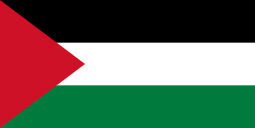


Notes
- In some ancient maps the town is also named Reggio di Lombardia.
References
- "Istat". Retrieved 2017-06-13.
- "Superficie di Comuni Province e Regioni italiane al 9 ottobre 2011". Istat. Retrieved 16 March 2019.
- Population data from Istat
- "Reggio nell'Emilia". The American Heritage Dictionary of the English Language (5th ed.). Boston: Houghton Mifflin Harcourt. Retrieved February 9, 2019.
- "Reggio". Merriam-Webster Dictionary. Retrieved February 9, 2019.
- "Community of Reggio Emilia". Beit Hatfutsot Open Databases Project, The Museum of the Jewish People at Beit Hatfutsot.
- http://gazzettadireggio.gelocal.it/reggio/cronaca/2014/12/02/news/dieci-pietre-per-gli-ebrei-reggiani-morti-ad-auschwitz-1.10420946
- "Reggio Emilia". Jewishvirtuallibrary.org. Retrieved 2011-04-05.
- "Reggio:". JewishEncyclopedia.com. Retrieved 2011-04-05.
- "Arpa Servizio IdroMeteo".
- "Arpa Servizio IdroMeteo".
- "Arpa Servizio IdroMeteo".
- "Atlante Eolico".
- "Archivio climatico Enea-Casaccia". [Enea-Casaccia].
- Accessed 10 July 2011. Archived February 25, 2012, at the Wayback Machine
- ""Balsamic vinegar"". Italiaregina.it. Retrieved 2016-02-05.
- "research on quality of life". Il Sole 24 Ore.
- "Twin Stayed Road Bridges Reggio Emilia". Milan, Italy: Redailli Tecna S.P.A. Retrieved January 2, 2017.
- "Three bridges in Reggio Emilia (Italy)" (PDF). European Steel Design Awards 2009. Brussels, Belgium: General Secretariat, European Convention for Constructional Steelwork. 2009. pp. 16–17. Archived from the original (PDF) on January 5, 2017. Retrieved January 5, 2017.
- Ascarelli, Alessanda (2004). "Gucciardi, Giovanni", Dizionario Biografico degli Italiani, Vol. 61. Treccani. Online version retrieved 1 October 2013 (in Italian).
- Council of Europe (2011). "Intercultural city: Reggio Emilia, Italy". coe.int. Retrieved 22 May 2011.
- "Eurotowns".
- "Gemellaggi e dichiarazioni di amicizia". comune.re.it (in Italian). Reggio nell'Emilia. Retrieved 2019-12-16.
Bibliography
External links

- Monuments and history
- Pictures of Reggio Emilia
- Official tourist information in English
- Reggio Emilia weather and webcams
- Reggio Emilia's basketball team
- Reggio Emilia's baseball team
- Reggio Emilia's softball team
- Reggio Emilia's International String Quartet Competition Premio Paolo Borciani